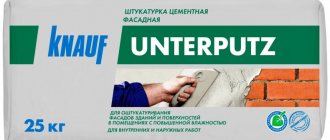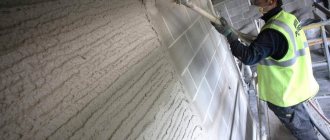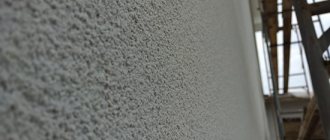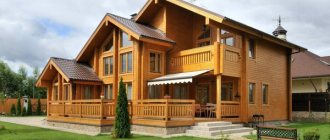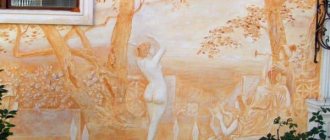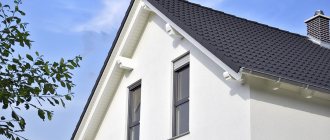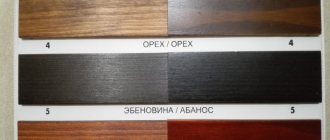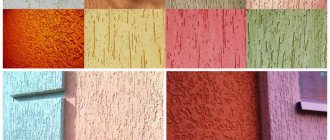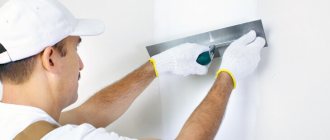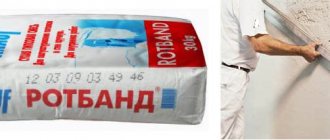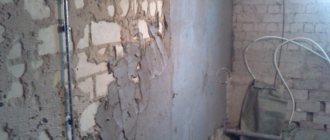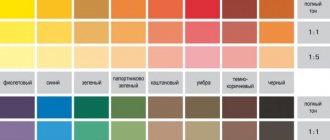To improve the façade, materials are used that not only have aesthetic qualities, but also have characteristics such as strength, resistance to natural influences, and durability.
A proven facade material is plaster : it has been used for quite a long time, and the latest technologies make it possible to produce this type of cladding with better characteristics.
How to choose plaster for the facade and not make a mistake, we will find out in this article.
Various types of facade plaster
Facade plaster comes in the following varieties:
- "Bark beetle";
- With pebbles;
- In the form of a mosaic.
Bark beetle facade plaster is justifiably considered the most popular, which has a strong effect on many, and besides this:
- It is light in weight and does not put much strain on the walls;
- Safe from an environmental point of view, that is, without the presence of components harmful to health;
- Holds well at large temperature differences in the range from minus fifty-five to plus sixty;
- Does not lose its appearance in direct sunlight;
- Cleans well with a sponge and vacuum cleaner;
- Looks great with a variety of dyes;
- Affordable.
Application of this type of facade plaster for external walls is carried out using a grating method using the grains contained in the composition. They are what make an attractive drawing.
Types of insulation
Very often, many people who are building their own house have a question about which insulation is best for a facade under plaster. Construction stores offer several options that suit everyone in one way or another, but at the same time have several differences.
Most often, polymer or mineral boards are used to insulate buildings, each of which has its own specific properties, parameters, difficulty of use and cost.
Depending on these differences, it is necessary to choose the material for insulation under the plaster facade of the house.
Mineral insulation systems
A distinctive feature of mineral insulation systems is their vapor permeability . In addition to this property, they are non-flammable material and have a fairly high strength index.
Unlike polymer boards, mineral ones are somewhat heavier and can absorb a small amount of liquid, even though they are treated with special water-repellent compounds.
Mineral insulation
For uneven facades, it is best to use two-layer products. Their top layer is more rigid and dense, while the lower inner layer is soft and easily adheres to uneven surfaces of the wall.
In order for mineral panels, just like facade plaster, to work in addition to each other, you need to use only vapor-permeable materials . This will allow the walls to “breathe”, which will make the ventilation in the house quite good.
Expanded polystyrene insulation systems
Distinctive features of expanded polystyrene, popularly called polystyrene foam, are its light weight, ease of use, and water resistance. It does not get wet at all and water cannot destroy it.
This material is vapor-tight, which is why the walls will not “breathe” when used. That is why the property of facade plaster, through which steam passes, can be leveled.
It is best to use slabs that have high strength. The ideal option is a material treated with fire retardants, since the foam itself tends to burn and melt. With this additive, this property of this polymer is significantly reduced, since it self-extinguishes when exposed to fire.
Expanded polystyrene insulation
This will not help if the fire spreads from an external source, but spontaneous combustion stops within four seconds. This is important due to the fact that foam plastic during the melting process releases a large amount of toxic substances that affect people in the building.
Polystyrene foam is not destroyed by water, but it reacts to ultraviolet radiation, as well as materials containing bitumen. It is worth noting that foam panels are cheaper than mineral ones.
There is also a type of extruded polystyrene foam, which has better properties, but is more expensive. When used in facade systems as insulation, it is the best material.
Which insulation is better
When choosing insulation, you need to proceed not from the properties of the insulation itself, but from the properties of the walls on which it will be used.
If the materials are highly vapor permeable and have low thermal conductivity, it is better to use exactly the same insulation - mineral. This applies primarily to wooden frames and walls made of large-porous expanded clay concrete.
If the external walls were made of sufficiently heat-conducting materials, such as brick, concrete blocks, slag and expanded clay concrete, both polystyrene foam and mineral insulation panels can be used.
Unterputz
Before carrying out decorative finishing, you should first prepare the wall. In this case, Unterputz façade plaster is an excellent option for any mineral base (gas blocks, brick, concrete).
This mixture is made up of various cement additives and sand. Its universal qualities are well used in places where there is high humidity and heavy load, both for exterior and interior finishing.
Its obvious advantages are:
- The presence of good plasticity, when the mortar mass can be applied in a layer of ten to thirty-five millimeters;
- Increased moisture resistance;
- Possibility of application, both machine and manual;
- Neutrality and efficiency.
The best manufacturers of gypsum plaster
When choosing a material, everyone will think about what material and from which manufacturer will be better for finishing the facade. According to the latest surveys of builders, KNAUF is in first place. This company has been a leader for many years. Following it is a product from VOLMA, but also in third place is BERGAUF.
"Knauf"
The most profitable option for finishing the room is Knauf Grünband or Rotband cement plaster. The porous structure is formed by polystyrene foam granules; accordingly, this treatment of the wall gives the layer a thermal insulation effect.
Experts believe that this material is easy to apply. Due to the fact that the mixture is moisture resistant, it is used as the basis for the surface of walls.
"Volma"
The mixture under the Volma brand is produced by a Volgograd company. Facade gypsum plaster consists of a cement-sand component. Gypsum plaster has all the advantages of a building material. But due to its high cost, it takes only second place on our list. It is difficult to imagine that any other material can replace this material, since the moisture resistance and originality of the material cannot be replaced by others.
"Bergauf"
The price of gypsum-based material is presented at an optimally low level. Bergauf developers offer equally high-quality material that is ideal for different situations. Bergauf is used for sealing hard bases with normal room humidity.
The material can also be used as a decorative coating. Recommended material for finishing walls and ceilings. When plastering and applying 2-3 layers, a crack does not form. The maximum permissible material thickness is 30 mm.
Pebble and mosaic
A variety of patterns helps to achieve finishing using stones in the composition. The most famous are “polka dots” or “fur coat”. Thick crumbs of natural origin densely cover the entire surface, so the facade has a special appearance.
In addition, it does not require additional painting at all, and such plaster lasts quite a long time without changing its qualities.
Characterized by:
- Low cost;
- Protection from external factors;
- Easy to apply.
Marble chips for the facade are classified as a mosaic type of plaster frame. Made from various types of granules, it is more durable and looks very beautiful on the walls.
If you follow the rules when applying plaster, the surface will look just perfect - dense and solid. Uniqueness is created due to the presence of grains of different sizes in the mixture, which form the necessary mosaic pattern on the walls.
If the obvious advantages are resistance to the sun and vapor permeability, then there is one disadvantage, but it is extremely significant. It is very difficult to restore the damaged part.
Advantages
Facade plaster is one of the most popular materials for finishing houses due to the large number of advantages and useful qualities that it has.
Among them, we can highlight a whole list of various reasons that force building owners to give preference to it:
- extending the service life of the building;
- low weight;
- the ability to level out roughness;
- protection from natural conditions;
- thermal insulation properties;
- low labor costs for application;
- optimal price;
- wide range of products, etc.
Facade plaster protects walls from the effects of aggressive and unfavorable climatic factors , which significantly increases the service life of the building itself.
Changes in the temperature of the external environment, heavy rain or snow, wind or scorching sun are not dangerous for many types of plaster mixtures and solutions.
Facade plaster
Since this material is applied to the walls in a fairly small layer, it does not exert a significant load on them. Therefore, you should not worry that the impact of plaster on the load-bearing parts of the building will have a negative effect.
Facade plaster does not require perfectly smooth walls, since it itself is a material capable of leveling them slightly. With the help of facade plaster, you can hide some of the shortcomings, roughness and flaws of previous work on the facade of the building.
Mixtures for facades allow you to retain heat in the cold season and provide ventilation in the warm season. Very often they are supplemented with special insulation, which only enhances this property of the material.
Thanks to this, home owners will be able to feel quite comfortable in them, and also save on heating when needed. Sometimes, due to the fact that the plaster mixture is vapor-permeable, it is compared to ventilated facades, since it does not allow condensation to accumulate on the surfaces of buildings.
Application of facade plaster is quite simple and easy. This work is quickly completed and does not require significant labor costs. That is why the cost of finishing a house with such material is not very high. Many people in the country can afford this.
If you wish, after completing the plastering work, the facade itself can be painted in any color with facade paint.
Application
It is also important to note the protection of façade plaster walls from some mechanical damage. First of all, this concerns light damage that occurs specifically to it, and not directly to the building itself.
The use of facade plaster for wall decoration can create a unique solution for decorating the exterior of a building, which is associated with many possibilities for its application and a wide selection of mixtures. They are distinguished not only by their price and color, but by their texture and texture.
A good builder knows many ways to apply any of the materials to the walls, so you can create the ideal finishing solution for the building.
It is worth noting that there is no better or worse plaster for the facade. Each of them has certain properties and is suitable for certain homes. The choice must be made based on those parameters that are of greater importance for the building.
For more information about facade plaster, watch the video:
Travertine
A fairly popular variety is travertine facade plaster, which imitates the natural nature of stone. Thanks to it, facade walls are highly practical, along with a spectacular appearance.
When applying such a coating, it is necessary to have both experience in such work and the appropriate skills. That is why it is most often performed by qualified specialists who have a certain specialization in the field of finishing.
The composition is based on natural stone. Italian and Russian manufacturers have achieved amazing similarity of the coating with the texture of natural material.
If we talk about the fundamental features, they include:
- The ability to create facades that are unique in appearance and have a high level of aesthetics;
- Complete safety from an environmental point of view;
- Easy application and low maintenance;
- Resistance to harmful microorganisms and the ability to “breathe”.
Thanks to this type, buildings look very impressive and can be easily tinted. If desired, it can be made both in pastel tones and in more saturated shades, which allows it to determine its special place in the interior style.
The binders in the composition allow classification into:
- Silicate with liquid glass, which does not have high strength characteristics, but has excellent vapor permeability characteristics and adaptation to atmospheric manifestations;
- Mineral based on cement or limestone. It has excellent strength and resistance to external influences. Universal. Can be used for finishing, both from the inside and from the outside.
Kinds
Every year the number of manufacturers of facade plasters is growing. This also affects their range.
At the moment, there are only four types of plaster mixtures for building facades, which differ not only in their cost, but also in many of their characteristics, as well as in the work with them.
Experts identify the following façade plasters:
- mineral;
- silicate;
- acrylic;
- silicone.
Mineral plaster mixture is quite often also called cement. Its distinctive feature is its high price.
Mineral plaster is used in cases where they want to achieve the longest possible service life without additional repairs.
In addition, such a plaster mixture is vapor-permeable and water-repellent. The bigger problem is the number of colors of this material.
Mineral
Therefore, in order to achieve the exact result that the owner wants, it is often necessary to paint it after applying the mixture, for which silicate paint is best suited. This will allow you to achieve the necessary aesthetic result, and will also increase the performance properties of the façade plaster itself.
Mineral plaster based on liquid glass is a less expensive material. But it is best used only for certain types of walls built from aerated concrete or shell rock.
Silicate plaster mixture is quite easily used as a finishing material. At the same time, it dries quickly, which is why cracks may appear on the facade, which will have a negative aesthetic effect on the building itself.
It is best to use silicate plaster, which does not allow cracks to form.
Silicate
Silicone plaster material has a very wide range of different colors , so the home owner can choose exactly the color that he sees fit.
In addition, such silicone surfaces have self-cleaning properties, which is why they do not need to be changed frequently, even in a polluted urban environment.
Silicone
Acrylic plaster is best suited for buildings with little shrinkage . This material is sold ready-made. It has a wide range of colors and good quality characteristics.
Acrylic
It is worth noting that when choosing, you need to pay attention to the brand of the mixture, based on which it can only be used on certain surfaces and under certain conditions.
The most popular at the moment are various types of structural plasters.
Building owners give their preference to “bark beetle” and “lamb beetle”. Each of them has its own unique look, which emphasizes certain elements of the houses.
Bark beetle
Options for applying facade plaster
Three main types of application technology:
- In one tone with the formation of a beautiful surface, very similar to the texture of natural stone;
- With a combination of one or more shades, formed by alternating light areas with dark ones. The surface can be “aged” if a silvered substance is used for this purpose;
- A special torn technique, when the formation of a patterned part is achieved by applying layers with different colors in a chaotic order. This way you can get a unique pattern.
If we talk about technical design, it can be textured, monolithic, or clearly imitating natural stone.
What is the final layer of plaster?
Finishing plaster is necessary to make the walls even for subsequent work. The following problems can be solved with the help of plaster:
- Filling space with some unevenness;
- Elimination of minor mechanical damage;
- Making the surface smooth and even.
At the same time, not only finishing plaster solves problems. Craftsmen use the primer several times, especially paying attention to uneven areas. Sandpaper, which is used to clean certain areas, also helps eliminate surface defects.
The properties of the final finishing plaster resemble ordinary plaster and putty. It is necessary not only to add a perfect application of this composition to the walls, but also to make sure that it has the correct texture. Otherwise, the plaster may crumble along with the paint applied later or with the wallpaper glued on it.
Photo of facade plaster for exterior work
How to prepare the mixture
Based on the setting time, the material is prepared according to a certain diet. Often, when preparing a solution, you should adhere to a 3 to one diet. That is, one liter of water is used for three kg of plaster. Sometimes the specified diet can be changed and the composition made more liquid.
Gypsum plaster for the first treatment sets very quickly, so you should use the entire created solution within 5 minutes. Therefore, it should be done only in parts if the finisher does not have special professional skills.
You can mix the mixture with a construction mixer or manually using a spatula. The material itself is viscous in composition and fits well on any surface. The applied material dries in 4-5 hours. The solution for external use can be applied in several ways:
- manually;
- mechanically.
The first option is carried out using a spatula. But, and the second - using a mechanical device.
Types of material
To give the surface an even, smooth appearance for further facing work, waterproof plaster is applied, which serves as an excellent bonding layer, creates reliable protection, and is simply decorated using paints, tiles, and a second layer of mortar applied in a special way. Apply directly to the prepared surface, cleaned and degreased. The use of such material prevents condensation from contacting the wall.
The decorative mixture allows you to form various patterns on the wall: “bark beetle”, “rain” is obtained from a solution with the inclusion of small, identical particles, “lamb” and a soft “fur coat” are obtained by using a mixture with large occurrences, which are evenly covered with the solution and covered with a durable layer the whole wall. One of the varieties of moisture-resistant plaster with a beautiful appearance and excellent performance characteristics is Venetian plaster. The surface is additionally treated with wax and resembles a ceramic tile coating.
Features of working with the material
When working with moisture-resistant plaster, it does not differ from the accepted application methods. Installation features should be taken into account:
- Surface preparation. It is necessary to clean the wall from the old crumbling layer of plaster.
- The joints of the brickwork are deepened by 5-10 mm. For alignment, small notches are made on the wall for better adhesion of materials.
- Remove dust and dirt. Treat the surface with primer twice, allowing the first layer to dry thoroughly.
- Mix the solution according to the instructions on the package.
- Apply the plaster in three layers: spray, base, coating. The thickness of the first layer varies between 5-10 mm and is intended for the initial leveling of walls. The cape must be completely dry. The thickest second layer, up to 3 cm, is applied the next day. The work is carried out with a wide spatula, using a long rule to remove excess mortar. The finishing layer of 1.5-2 mm is applied after the previous layer has completely dried, after wetting the surface with a small amount of water. The movements are wave-like. On wet plaster, grout with a wooden float counterclockwise. Repeat with felt for smoother alignment.
- The surface is ready for decoration.
Important: for ease of work, beacons are pre-set, which serve as a guide to the thickness of the plaster for a given surface.
Among the wide variety of finishes for the facade of a building, moisture-resistant plaster is distinguished by increased performance characteristics, accessibility, and the ability to aesthetically decorate the walls at your own discretion.
Mineral
This type of plaster is characterized by the fact that the basis for it is cement. The mixture usually consists of cement, river or sea sand, and lime.
Manufacturers add plasticizers and modifying additives to the mixtures, accelerating setting, imparting frost resistance or corrosion resistance.
The positive qualities of mineral facade plasters are:
- mechanical strength and good adhesion to the building facade:
- combination of water-repellent properties with vapor permeability;
- resistance to temperature changes;
- relative cheapness.
Negative sides:
- is not subject to tinting, so to change the color you have to use facade paint after finishing the plastering work, the choice of colors is poor;
- without the addition of plasticizers, very low elasticity and tendency to cracking.
Gypsum plasters that have recently appeared on the market are afraid of prolonged direct contact with water, and due to the abundance of polymers in their composition, they do not allow steam to pass through and are not environmentally friendly.
Mixtures for manual and machine use
Gypsum plasters are also distinguished by the method of their application. According to this criterion, two types of compositions are classified: for manual and machine application.
Mixtures of the first type are distinguished by a large number of chemical additives, since their main task is to provide optimal time for manual production of the batch. Adding chemicals to the composition allows you to increase the time for the solution to start setting to 40-60 minutes. Thus, in just 4-5 hours a full cycle of work on the external or internal finishing of buildings and premises can be completed.
Gypsum facade plaster - an environmentally friendly coating for a residential building
Gypsum plasters intended for machine application have different tasks. These compositions should have a longer setting period (from 1.5 to 2 hours), since the master needs to process a significant amount of surfaces during this time. The work is carried out in two stages: applying a plaster mixture to the wall with a special gun and leveling this layer. The long period of setting of the composition ensures that the master will have time to complete the full cycle of tasks required by the technology.
Plastering walls by machine
Mechanical plaster
The gypsum composition is fed into the gun through hoses connected to a specialized machine for preparing wet plaster from a dry mixture. For better mixing and to ensure unimpeded passage of the solution through the hose system, fractionated sand (crushed to particles of a certain cross-section) is added to the mixture.
Wet plaster technology
Wet plaster technology is used to create a comfortable indoor microclimate. The process of applying wet plaster: the walls are primed, insulated with mineral wool or polystyrene foam, then the material is secured with reinforcing mesh, and after that facade plaster can be applied. Sometimes, to increase the bonding properties, another layer of primer is required before plastering.
Advantages of wet plaster:
- plastering without joints;
- the ability to cover cavities and uneven walls;
- reduction of heat loss;
- high adhesion to different materials (brick, concrete, wood, etc.).
In order for the wet facade to remain durable and strong, it is important to correctly apply the reinforcing layer. Its thickness should be less than six millimeters. The reinforcement consists of 3 layers: adhesive, fiberglass reinforcing mesh, and adhesive again.
Stroybrig
The product is notorious for its history of a lawsuit against a user who was justifiably dissatisfied with the quality of the self-leveling floor.
The assortment is large, there is a choice within each type of product. Facade plasters are presented in 7 gradations of cement-sand mixture, marked with a code from “7.5” to “24”. The differences are in setting time, strength of the finished layer, cost, characteristics of adhesion to the main surface.
Thus, “7.5” determines the presence of particles up to 1.25 mm and flow rate up to 20 kg/m²; this solution works for 2 hours; it can be laid in a layer of up to 20 mm - acceptable for leveling out local differences. Option “24” – fraction up to 2.5 mm, consumption 10 kg/m²; works 3 hours; a layer of up to 30 mm is allowed - used in insulation systems.
A beginner will have to work with this line of plaster mixtures for a very long time, which is not always convenient.
Because to form the correct layer from the wall to the paint, you need to use several mixture options and intermediate primers. Characteristics of the composition of Stroybrig Tanilit
| Characteristics | Tanilith 7.5 |
| Purpose | |
| Astringent | Cement |
| Application temperature, 0C | 5…25 |
| Layer thickness, mm | 5-20 |
| Consumption, kg/m² (layer 10 mm) | 18-20 |
| Viability of solution, min | 120 |
| Price per bag 25 kg, rub. | 130 |
Stroybrig cement plaster option:
Tips and tricks
- Decorative finishes for wet rooms should be chosen with the least pronounced textures. You should not use decorative plasters of the “bark beetle” type, in the grooves of which, under conditions of high humidity, microorganisms can accumulate and mold and mildew can develop.
- Surfaces in direct contact with water are best tiled.
- To prevent the formation of mold on decorative plaster, add antiseptic compounds to the composition when mixing or use primer mixtures that already contain them.
- When preparing plaster mixtures yourself, strictly follow the dosages of the components and recommendations for their production.
- Adding liquid glass to the solution will help improve moisture-proofing properties.
